.
Marina Genkina
GROBMAN'S SKY
Michail Grobman - the artist, the poet, the
collector, the expert in the fields of art history and theory, was born
in Moscow in 1939, and at the end of the '50s became one of the co-founders,
as well as a participant in the literary and artistic movement nowadays
known as the Second Russian Avant-garde.
The unique nature of the new Russian avant-garde
resulted first and foremost from the fact that it originated in a situation
where the reigning official aesthetic doctrine rejected both the conceptions
prevalent in the contemporary world art and the Russian and Western artistic
traditions established at the beginning of the twentieth century. The Second
Avant-garde did not have a generation of «fathers»; the normal continuity
of artistic traditions was interrupted, and, unlike their Western contemporaries,
the artists of the Second Avant-garde were motivated by the generation
of «grand-fathers». The study of the «grand-fathers'« heritage and its
criticizing, as well as mastery of the contemporary artistic language -
all these were com-pressed into a period of less than ten years. Another
component which greatly determined the traits of the new Russian avant-garde
was its forced nonconfor-mity: although they were subjectively far from
politics and took no active part in the actions of the dissident movement,
artists of the new avant-garde were still considered by the regime an integral
part of this movement, and were - objec-tively - dissidents. The consequences
of this status were twofold: on one hand, the artists of the Second Avant-garde
remained for a long time - almost until the mid-Seventies - independent
of the cultural establishment; on the other hand, they existed in a certain
vacuum, being deprived of normal, non-ideologi-cal, non-political criticism,
both from the Soviet and from the Western side. Thus, the new Russian art
was developing in an original and independent manner - simultaneously with
Western art, but under dissimilar circumstances.
This mode of development was formulated by
Grobman in a short foreword to one of his exhibition catalogues issued
in Israel in 1982: «While the opponents of the regime were rejecting the
totalitarian order, though they did not offer any positive program, the
literary and artistic avant-garde ignored the reformative problems and
devoted much attention to the search and design of new spiritual ways
and directions. These two phenomena were not contraposed, but each
was moving through its own channel.» [Italics are mine -M.G.] (1).
Among the major features characterizing Grobman's
creative activity since the early years, the following should be specified:
his works are both vanational and holistic at the same time.
During each period he develops several different
thematic and stylistic directions concurrently. A similar elaboration is
performed within each direction as well: usually he presents series-variations,
but single works which are created during a certain period and do not belong
to any series can also be combined into groups, based on thematic or stylistic
affinity.
A similar phenomenon can be discerned when
considering Grob-man's creative activity along a temporal axis: comparing
his recent works to his earliest ones, we can see that the foundations
- the main ideas, subjects and iconography - were laid in the early '60s,
and were subsequently developed rather than denied. Grobman's oeuvre
may be regarded as variations on several themes, which are interrelated
both semantically and iconographically, using a vast variety of artistic
means.
The late '50s - the initial period of Grobman's
creative activity - were the years of learning, when, like other artists
of the Second Avant-garde, he studied con-temporary styles, techniques
and trends. «It was the period when I comprehended various artistic techniques.
Among those who attracted me most of all were Chagall, Paul Klee, and,
of course, Russian Futurism. I also liked the French Tachists and the American
Abstract Expressionism. Simultaneously I started drawing nearer to folk-art
-lubok and icons» (2).
In 1958 Grobman produced a series of cubist
drawings: figures of musicians with musical instruments; in 1959 he painted
a series of monotypes entitled The Love (where the inspiration of
Larionov's draw-ings is discernible), a cubo-futuristic series with dancing
acrobats, and The Black Square, the product of his contemplations
on Malevich's art. The Portrait of the Old Jew, where the cubo-futuristic
construction is combined with a painting technique reminiscent of Abstract
Expressionism, was done in 1960. This work may be regarded as marking the
end of his earliest period which was influenced by early twentieth century
Avant-garde classics.
During the next several years, until the mid-Sixties,
the semantic and figurative foundations of Grobman's artistic language
were laid, and the symbol in its mystical and conceptual personification
began to play a leading role in his works; this entailed a transition toward
a fundamentally different pictorial language and an essentially different
spatial structure, incompatible with the linear perspective and illusionist
space.
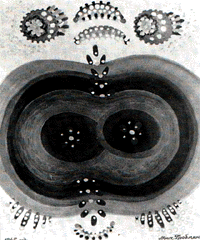
APPLE, 1968
«The possibility of combining folk, anecdotal
artistic thinking with an abstract, constructionist thinking opened possibilities
for the devel-opment of my own artistic language... I began to consider
pictures as relying primarily on intellectual principles, whereas sensuality
became a secondary element. I became interested in the problem of combining
pictographic elements with free geometrical forms» (3).
It was a new conceptual approach. By «conceptual»
I do not refer to conceptualism as a trend, since the key principle of
this trend - the creative act as an end in itself, the prevalence of the
process over the result - contradicted the goals of artists belonging to
the early Moscow Avant-garde. I do refer to a conceptual approach that
believed in the leading role of the abstract idea to which all expressive
means are subjected. The artists of the Second Avant-garde - Grobman, Kabakov,
Rabin - were the first in the history of Soviet art to proclaim this principle
in their creative activity; thus they objectively became the precursors
of the Moscow Conceptualism - a trend which took shape in the mid- Seventies,
and later developed into Sots-art and the art of the '80s with its happenings
and performances.
From the very beginning of his artistic career,
Grobman's works can be divided into two major groups. One was defined by
the artist himself in the '60s as «magical symbolism». This term is associated
with a specific period in art history, and the word symbolism emphatically
indicates the genealogy of Grobman's art - from Byzantine icons and primitive
folk art to P. Klee and the abstract expressionists. However, by adding
the word magical he introduces an essentially new factor into this definition:
contemplation and involvement typical of the beginning of the century give
way to an impersonal conceptualist demonstration with the aim of showing
the object-action interrelations thus being transformed into a magical
action whose goal is to change the world and not only ascertain its mystical
essence. Many years later, this aspect was manifested in Grobman's conceptual
projects and in the actions of the Leviathan Group.
For more than thirty years, from the early
'60s to the present, the artist has created, within the framework of magical
symbolism, the great sacral World, with its Water and Dry Ground, Heaven
and Hell; a World mottled with magical signs, letters and words, a World
with its own symbolic fauna and flora.
Grobman's works belonging to the second group
depict the conceptually transformed reality of actual and historical events,
common notions and modern art - everything that exists or ever existed
in the concrete space and time.
Nonetheless, both groups intersect and adjoin
regularly; they are interrelated and interconnected; the artist uses the
same expressive means, the same signs and symbols - both traditional and
new, which rely on the traditional; Grobman's «magical symbolism» is essentially
conceptual, and his «actual» works are based on symbols. The «magical symbolism»
works (from the early '60s) comprise several similar, though stylistically
different directions, of which the most important were (1) geometricalized
metaphysical compositions based, as a rule, on the monochromatic gamut
and vertical symmetry, using symbols, attributes, and sometimes allegories,
and (2) decorative compositions which go back to folk art, with fantastic
characters, bright local colors and spatial patterns a la Lubok.
This was also the period of Grobman's first
collages on historical subjects; one of. the most famous of these, The
Generalissimo (1964), was the precursor of Sots-art - the trend which
developed almost fifteen years later. But The Generalissimo was
not the only work based on Soviet mythology, and - in particular - on the
use of its main image; it was preceded by various chamber happenings organized
for close friends in which Grobman used the ready-made pseudo-artistic
Soviet production, Stalin's portraits, which could still be found in the
warehouses of Soviet offices. During this period Grobman also created a
series of works dedicated to certain episodes in Russian history in which
the historical myths were used for their deconstruction.
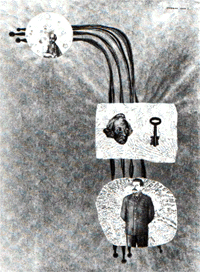
GENERALISSIMO, 1964
In the late '60s Grobman was developing the
specific forms of his artistic language, with the domination of «magical
symbolism»; the «actual» works were, as a rule, structurally closer to
these than to purely conceptual ones. During this period, practically all
his iconographic types were created, types which can still be found in
his current works: the symbols, the signs, the fantastic symbolic personages.
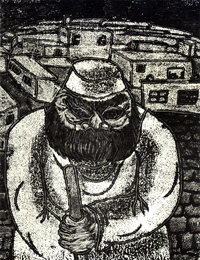
THE NIGHT WATCHMAN, 1964
Gradually, the artist began to deny his former narrativity, and one
of the consequences was that he ceased to depict human beings. There were
still human figures in his works, but these acquired a different meaning
and character; they were no longer portraits or figures in paintings of
this or that genre, but rather, like all other elements of his works, had
become symbols. The decisive transition to the semiotic system of expression
was completed in Grobman's work The Porcelain Man (1965) which served
as some kind of a manifesto: a conceptual depiction of a man in an abstract
environment, with an emphasized application of the decorative mode typical
of folk art.
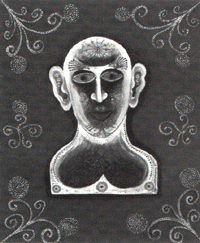
PORCELAIN MAN, 1965
These new ideas led to new spatial notions: in Grobman's
earlier works the composition orientation was horizontal, as in secular
European works of art, and Heaven and Earth were presented as differentiated
material objects; in his works of the new period we can see an indivisible
mystical space, where the top and bottom are distinguishable only in a
sacral sense, and are replete with corresponding symbols. Vertical becomes
the dominant orientation; it is the pivot which, especially in case of
the centralized composition, unites the top and the bottom, bridging the
gap between all the elements. In the late '60s the artist introduced the
diagonal as the composition's orientation, suggesting its role in sacral
art: a diagona which aspires to reach the sky, thus remaining in the realm
of the Eternal, brings together static and dynamic forms; it symbolizes
their indissoluble nature, thus providing a solution to the «top-bottom»
conflict. The dynamics of the diagonal in this situation is not the pathos
of immediate formation, nor the emotion of the moment so typical of secular
art, but the energy of the Eternal.
Thus, by the beginning of the 70s, the remainders
of secular art were completely overcome. Henceforth the World created by
the artist is interpreted as the indissoluble and dynamic Universe, whose
elements are all interrelated. Thus, the proximity of «actual» and «mystical»
works (which was already revealed in the early '60s) becomes a natural
manifestation of the unity and multi-dimension-ality of the Universe.
In 1971 the Grobmans came to Israel. As an
artist he was faced with a rather complicated situation. Against the background
of the already existing Israeli abstractionism, Israeli art in the '60s
(which since the beginning of the century, had been forming under the influence
of artistic ideas and styles brought by successive waves of repatriates)
began to pattern itself after American art. The dominant ideas were conceptualism
and pop art, especially in their American versions, ideas which were suitable
for the US, but not for Israel.
The things Grobman could do - and was actually
doing -contradicted the generally adopted attitudes and tendencies.
For Grobman it was unacceptable to repeat
either the achievements of modern American and European art or his own
Moscow innovations. His practice was different: he wished to develop the
major ideas of the Second Avant-garde, their sum and substance -namely,
the contraposition of a sign system in art to realism and illusionism in
all their manifestations, including the most current ones - and use those
elements of the world's avant-garde which corresponded to his own goals,
while rejecting the means which contradicted them, whether these were introduced
by himself or by somebody else.
And then, as if summing up the results' of
his twenty years of activity, Grobman formulates the basic tenets of his
approach to artistic ideas, specifying how his symbols and signs should
be interpreted. The irregular notes of previous years became a system-atized
conception (4). These theses, together with extensive excerpts from
his diaries, were published in The Leviathan Newspaper founded by
Grobman in 1975.
However, this was not only a summing-up, but
also the beginning of a new phase. In 1975 another Leviathan was
established by Grobman - a school in the most basic sense of the word;
i.e. not a group, but rather an educational process. This Leviathan
was comprised of various artists, both re-patriates (not only from the
Soviet Union, but also from other countries) and native Israelis. Grobman
expounded
his conceptions in the newspaper and in catalogues published for the Leviathan
exhibitions-actions. Defining in his manifestoes specific positive goals
and tasks, Grobman rejected -as obsolete and restraining -not only the
classical realism, but also many modern trends, thus infuriat-ing the advocates
of such trends.
«Using the name of pluralism as a cover, the
satiated public undermines the aesthetic and moral foundations of our civilization.
Realism is their general favorite since realism in art is the exultation
of egoism, self-admiration, self-enjoyment. (...) Realism (...)in its objects
or artistic actions appeals to the prosaic logic of housewives. (...)
Hyper-realists, hand in hand with the ex-outcast
pop-art, servilely serve the surfeited bourgeois the most pungent and savory
garbage modeled with maximal realism.
Artists, like blind puppies, bustle about new art techniques, but neither
performance nor video can be content in and of themselves - just as the
very fact that the picture was painted in oil or in watercolors cannot
be its content. (...)
Plot and illusions, perspective and psychologism,
prose and pseudo-science -all these are worms in the body of artistic avant-garde...»
(5). Having been the co-founder of conceptualism, Grobman now regards
this trend as one of the obstacles in the development of new ideas, as
a heritage to get rid of.
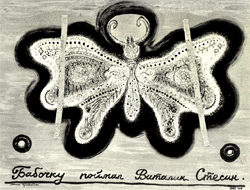
STESIN"S BUTTERFLY, 1966
«...The so-called conceptualists (...) dig
the grave for the supreme language of humanity, for the symbols of absolute
Divine visual forms. The conceptualists' struggle with the form is another
symptom of the grave moral blindness (...) of this world.» (6).
«Three foundations define our artistic stand:
1. Primitive.
2. Symbol.
3. Letter.
«Our enemies are:
1. Historicism, psychologism, pathos.
2. Literary plot, visual illusionism.
3. Disdain for the material.
«Our action is work with the space and time
using all kinds of visible materials.» (7).
The practice of Leviathan conformed
to these declarations, thus implementing the ideas of the magical action
as a means of transforming the world; these ideas were devised in the '60s
and actualized in Israel on the synthetic level. Street processions were
organized in several Israeli cities and meetings were held in the Judea
Desert and by the Dead Sea; (8) participants' magical symbols, gestures
and acts led to an interaction with the environment: the sea, the mountains,
the sky, Jerusalem. Despite the formal resemblance, these actions could
not be treated as performances; on the contrary, they were organized without
spectators since magical actions do not tolerate strangers. Nevertheless,
the actions were documented in stills and video, and the material was detached
enough from the actions themselves, being the work of another, to serve
as basis for a more traditional art. These documentations were presented
at the third Leviathan exhibition (1982) along with paintings and
graphics. Simultaneously with these magical actions, projects of essentially
new architecture were conceived based on the idea of interrelation between
the structure of the architectural object, the environment, and the human
being, who was considered in the completeness of his physical and spiritual
essence. One of these projects was the construction of a magical-symbolic
theater whose design was to determine the nature of the dramatic works
to be staged therein. However, due to various reasons, none of these projects
has ever been implemented. In the late 70s, the mystical symbol became
the principal expressive means in both «magi-cal» and «actual» works. In
fact, the difference between these practically dissolves; the artist no
longer links symbol to plot, not even to the slightest extent, but only
considers the form and meaning of the symbolic expression.
«The circle, the triangle, the square -there
is nothing more precise than these notions, there is nothing more abstract.
The construc-tive function of these symbols in the visual world is to establish
peace, balance, analytical lucidity. (...) They are the language used by
the Lord when He addresses us.» (1974) (9).The specific role during
this period is assigned to letters: letters of the Hebrew and Russian alphabets,
texts written in these languages, and signs imitating ancient Hebrew script.
All these elements can also be found in Grobman's works of the Moscow period,
but now they have become permanent semantic and visual components of his
paintings; they appear in various combinations, in arrangements incorporating
both the usual Grobmanean iconographic types and new ones which were typified
in the 70s and '80s.
In the '80s Grobman produced several series
united by a common theme and composition device, and dedicated to death,
Satan and «black skies». In one of these works, Skeleton Satan,
accompanied by a swastika and spots of yellow paint (yellow is the color
of the Holocaust in Grobman's symbolism), is scudding through the inscription
which covers the entire surface of the painting and reads as follows: «Satan
is the state of the human soul when there is no love in this soul.» In
these works Grobman introduces for the first time the «topsy-turvy» motif,
using the well-known magical concept of mirror reflection.
Still producing works of «magical symbolism»,
in the late 70s Grobman increasingly turns to «actual» works. He addresses
various themes -social, political, religious; expresses his viewpoint on
cultural aspects, compiling albums dedicated to topical subjects; paints
a series of large-format gouaches; (10) and constructs sharp political
installations and objects.
The same can be said about Grobman's poetical
activity. The lyrical verses gave way to verses from the Military Notebook,
(11) and the protagonists of the latter were the brothers of the
main character in his series of gouaches (such transformation did not happen
all of a sudden, but concurrently with his artistic activity, going through
the same stages). Dispelling any doubts about his intentions, the author
writes in the foreword to this book:
«The folklore shell hides away not only
the physiology of society, but also the final and unreserved denial of
all contemporary poetry. Literature has got the pukes of poets. It is high
time to understand that everything needed by humanity has already been
written, and the only way to avoid being stiff-necked is to risk your own
neck» (12). Post-modernist tendencies became typical of Grobman's
works in the late '80s, and were distinctly manifested in the exhibition
Understandable Art (1993), a collective
action in which Grobman functioned as both curator and participant. These
tendencies are perceived as a logical result of his previous creative activity
which, being the basis of his art, still cannot be considered something
fixed and invariable, but on the contrary, it is in a state of constant
transition.
In his typical manner, Grobman verbally declares
his apprehension of current artistic tasks: «This is the renewed combination
of plastic ideology with social and public thinking. We want an artist
to hold his position in society far from a pearl-caster. I like many of
these things which have been done once. But I demand disobedience from
myself as well as from other people. Devotion to the ideas of the past
is suicide for an artist» (13).
Notes
1. Moscow Artists. Prospectus. Jerusalem:
Maler, 1982.
2. The Beautiful Sixties in Moscow, llya
Kabakov. Michail Grobman. Exhibition Catalogue. Tel Aviv: The Genia
Schreiber University Art Gallery, Tel Aviv University, August 1989, p.18,
3. Ibid.
4. See: The Leviathan Newspaper. Jerusalem,
1975, No 1; 1979, No. 2:1980, No. 3, and Zerkalo (The Mirror)
Magazine. Tel Aviv, 1995, No. 131, pp. 29-33.
5. Leviathan Group. Catalogue. Jerusalem,
Summer 1979, p. 1.
6. Ibid.
7. Leviathan Group Manifesto. Jerusalem,
1976. The Leviathan Newspaper. Jerusalem, 1979, No. 2, pp.14-25.
8. In the Summer of 1985 there was an action
dedicated to the Centenary celebration of V. Khiebnikov's birth. Concurrently,
this date was celebrated In Moscow, in Kabakov's studio. See: Europa,
Europa. Das Jahrhundert der Avantgarde in Mittel- und Osteuropa. Exhibition
catalogue. Bonn: Kunst- und Ausstellungshalle der Bundesrepublik Deutschtand.
1994, vol. 4, p. 58. There is a mistake in the quoted text:
the action is dated 1978.
9. The Leviathan Newspaper. April 1979,
No. 2, pp. 6-9,
10. See L. Kantor's essay in this edition.
11. M. Grobman. Military Notebooks. Tel Aviv:
Leviathan, 1992.
12. Ibid., p. 3.
13. M. Grobman. Interview given to M. Tuvia-Boneh,
Understandable
Art. Exhibition Catalogue, Museum of Israeli Art,
Ramat Gan, 1993,
p. 55.
Translated with Russian - Viktop Gopman
______________________________________________________________________________________
|